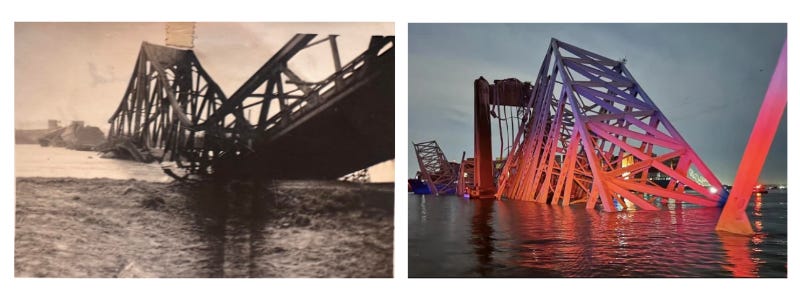In 1945, a steel bridge was rebuilt in six days
Last Tuesday, I saw a collapsed bridge. I also saw my grandfather.
I felt a range of emotions seeing the Francis Scott Key Bridge crumbled and half-underwater last week. Sorrow for the men lost. Fear for the possible cause of terrorism. Irritation on behalf of people who need to cross the bridge for their livelihood.
But I also was filled with a strange sense of familiarity. As I stared at my phone scrolling through the wreckage, I had the sense I had seen it before. A black-and-white image flashed in my head: Ah yes, it was just like one of the photos I have from my grandfather Vic’s time in Nazi Germany (aka “Rhineland” as it says on his papers) during World War II. The similarity was striking:
On the right is the scene from last Tuesday, via the Baltimore City Fire Department. On the left is my grandfather’s photo of the Duisburg–Hochfeld railway bridge that spans the Rhine River. Retreating Nazi forces destroyed it intentionally in March 1945, hoping to slow Allied troops.
The rebuilding of the 800-meter-long Duisburg bridge was measured not just in days, but in minutes. My grandfather, who had a seventh grade education, served as a U.S. Army combat engineer construction foreman for the project. He was one of hundreds of men who erected the bridge in a record-breaking “six days, fifteen hours, and twenty minutes.” It was dubbed the “Victory Bridge” and became a powerful symbol of American grit and ingenuity:

He did not speak of his time in the war except to say he worked on bridges and experienced “heavy fighting.” After the war, he threw away his medals in disgust, never explaining what made him so bitter. When I was ten years old, he died by suicide.
I share this sad ending not to make any sweeping statements about the challenges of rebuilding a bridge—and a life—under intense pressure. Instead, I share these side-by-side photos and his story to point out that when each of us wake up and see major news, we all see something different, informed not just by our current selves, but our elders who came before us, whose life stories make us who we are — for better or for worse.
The families of those who died on the bridge will hurt not just for years, but for generations. We will rebuild, but I also hope we’ll remember.
Related: The long echo of WW2 trauma
World War One and Vietnam are the wars most closely associated with post-traumatic stress - but it was also a huge problem for the combatants in World War Two, and one that may still be affecting their children and grandchildren today.
The Shrieking Cactus is an email newsletter for people learning to be less prickly in life, particularly for people who have experienced trauma, but all readers are welcome. Sign up here:





This is a great article, Joy, and a great memory of Vic, a man I wish I had known better.